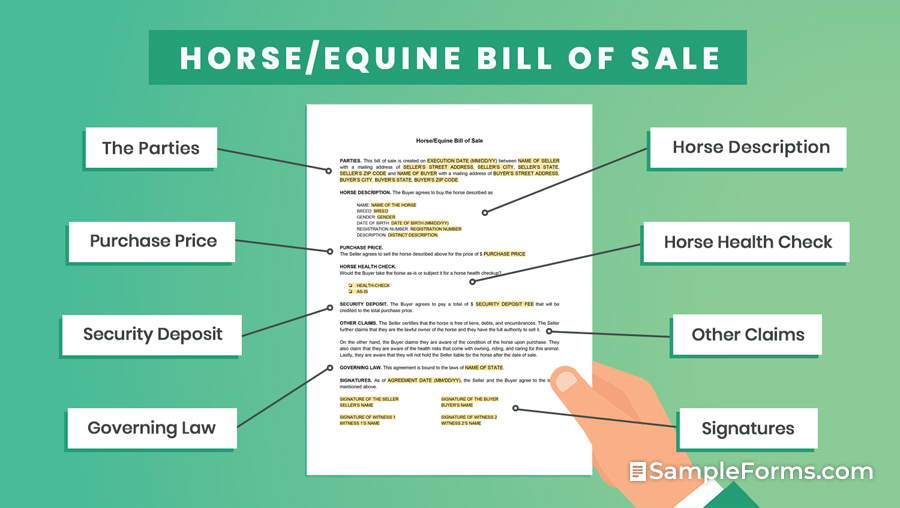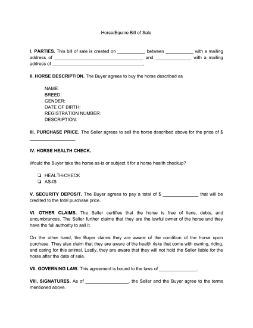- Eviction Notice Forms
- Power of Attorney Forms Forms
- Bill of Sale (Purchase Agreement) Forms
- Lease Agreement Forms
- Rental Application Forms
- Living Will Forms Forms
- Recommendation Letters Forms
- Resignation Letters Forms
- Release of Liability Agreement Forms
- Promissory Note Forms
- LLC Operating Agreement Forms
- Deed of Sale Forms
- Consent Form Forms
- Support Affidavit Forms
- Paternity Affidavit Forms
- Marital Affidavit Forms
- Financial Affidavit Forms
- Residential Affidavit Forms
- Affidavit of Identity Forms
- Affidavit of Title Forms
- Employment Affidavit Forms
- Affidavit of Loss Forms
- Gift Affidavit Forms
- Small Estate Affidavit Forms
- Service Affidavit Forms
- Heirship Affidavit Forms
- Survivorship Affidavit Forms
- Desistance Affidavit Forms
- Discrepancy Affidavit Forms
- Career Assessment - 16+ Examples, Format, Tips, Pdf Forms
- Undertaking Affidavit Forms
- General Affidavit Forms
- Affidavit of Death Forms
Horse/Equine Bill of Sale
The equine industry is considered to be part of the growing economy within the United States. The industry pertains to the core agribusiness activities related to the use and ownership of horses. It also extends to the services and other economic activities that provide related goods and services. So, expectedly, the buying and selling of horses are more common than outsiders believe. When it comes to these purchase transactions, you need a form to record the sale and to ensure the legitimacy of the purchase. Read on to know more about the other purpose and importance of a horse/equine bill of sale form. Read More
Horse/Equine Bill of Sale
What Is a Horse/Equine Bill of Sale Form?

Apart from serving as an accurate record, the form is also a legal document that concretizes the purchase in writing. More than that, the form also provides the necessary preparations for both parties, especially regarding the current health status of the animal. If agreed upon, the seller must subject the horse to a check-up to know its current health status and to inform the buyer beforehand. You also use A bill of sale form can also be used when the horse is given as a gift. Even if payment is not necessary for this arrangement, the other details in the form are highly essential for the transfer of ownership, registration, and caring for the horse.
How Do You Create a Horse/Equine Bill of Sale Form?
A horse bill of sale form requires the fundamental details of a legitimate sale transaction so, expectedly, it is a short and straightforward form. But still, regardless of its simplicity, simple errors may also occur. Here are some steps to review when you need to fill out this form. From the essential pieces of information down to reviewing your state’s laws, these are all important to record your sale accurately.
1. Know the Parties
The form starts by introducing the involved parties. This part essentially asks for the legal names of the parties together with their mailing addresses. Other than that, the execution date of the form is also set at this part of the contract. Knowing the involved parties in the transaction is enough evidence if, in case, one party decides to take advantage of the situation and not deliver what is expected from them.
2. Provide Accurate Description
The next piece of information to provide is a description of the horse. Similar to other types of bills of sale, an accurate representation of the item must be provided to ensure the legitimacy of the sale. In this case, you have to include the details about the animal. This list often consists of the name of the horse, breed, and gender. The date of birth of the animal is also a vital detail. And similar to motor vehicles and equipment, the registration number of the horse should be there. Apart from these data, the seller can choose to disclose more prominent features of the horse to provide a clearer and more accurate picture of the equine.
3. Mind the Health of the Animal
A stand-out feature of a horse bill of sale form is the stipulation regarding the health of the horse. This section usually asks if a health check-up by third-party providers are necessary, or not. Whenever necessary, the seller or buyer can demand a particular clinic to do the health check. If not, the horse will be up for sale in an as-is condition, therefore freeing the seller from any liability towards the animal once the sale is completed. The health of the equine is an important matter that you need to discuss with the buyer because it can significantly affect the value of the animal.
4. Settle the Payment Arrangement
In recording the details of a purchase, it is impossible to leave out the details regarding the price. It must record the total purchase price first before talking about the other terms of the payment. It is common to have a security deposit clause in this bill of sale form. For this condition, the seller must pay the deposit fee. The seller can choose to elaborate further if there is a limit to the number of days when the buyer can pay the deposit. And in these conditions, the deposit fee is non-refundable because it is carried over to the total purchase price.
5. Indicate the Claims
Indicate other claims in the latter part of the form. This part essentially includes the claim of the seller that they have no pending liabilities towards the horse. Furthermore, it also states that they are the legal owner of the equine, therefore, has the right to sell it. On the other hand, the buyer’s side claims that they are aware of the current condition of the horse and that they agree with pushing through with the sale. After these terms, both parties are asked to affix their signatures that will reflect their compliance with the arrangement.
FAQs
When is a horse bill of sale form useful?
A horse bill of sale form is necessary when buying and selling a horse. You also need it to rehome a horse. Rehoming means giving the horse a new home when the old owners are no longer capable of caring for the animal. The process is similar to gifting the horse.
Is a Coggins test necessary when selling a horse?
Similar to notarization, some states require Coggins upon the sale of the horse. For those that require the test, the buyer must have the document of the latest Coggins test of the horse. A Coggins test is a blood test that can detect the antibodies carrying the disease of Equine Infectious Anemia.
What is the price range for selling horses?
The ballpark for the low price of good-natured horses is around $5,000. However, the price can rise to more than $100,000, especially among rarer breeds. Horse breeds for elite shows have an even higher value than stated. Arabian horses, in particular, bear the highest value among all the breeds.
Who makes a living from selling horses?
Professional horse trainers make a living out of training and, ultimately, selling these horses. Expectedly, they are those who are most acquainted with this horse bill of sale form.
What are the ways of selling a horse?
There are three common ways of selling a horse. These are when the seller sells the horse personally. A horse can also be sold through a horse broker. The last method of selling an equine is through an auction.
Most people may take that equine industry as something good as dead or stagnant. But, it is one of the growing economies in recent years. The cycle of the purchase among horses is faster than what one might expect. With this trend, the use of the horse bill of sale forms remains significant over several years. So, if you have plans of entering this industry, make sure to acquaint yourselves with the how-tos of this horse bill of sale form.
